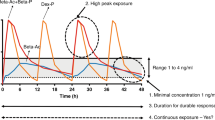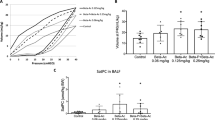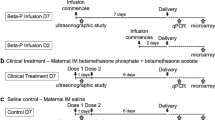Abstract
The study goal was to evaluate the transplacental transfer of two corticosteroids, budesonide (BUD) and fluticasone propionate (FP), in pregnant mice and investigate whether P-glycoprotein (P-gp) might be involved in reducing BUD transplacental transfer. Pregnant mice (N = 18) received intravenously either low (104.9 μg/kg) or high (1049 μg/kg) dose of [3H]-BUD or a high dose of [3H]-FP (1590 μg/kg). In a separate experiment, pregnant mice (N = 12) received subcutaneously either the P-gp inhibitor zosuquidar (20 mg/kg) or vehicle, followed by an intravenous infusion of [3H]-BUD (104.9 μg/kg). Total and free (protein unbound) corticosteroid concentrations were determined in plasma, brain, fetus, placenta, kidney, and liver. The ratios of free BUD concentrations in fetus versus plasma K(fetus, plasma, u, u) 0.42 ± 0.17 (mean ± SD) for low-dose and 0.38 ± 0.18 for high-dose BUD were significantly different from K = 1 (P < 0.05), contrary to 0.87 ± 0.25 for FP, which was moreover significantly higher than that for matching high-dose BUD (P < 0.01). The BUD brain/plasma ratio was also significantly smaller than K = 1, while these ratios for other tissues were close to 1. In the presence of the P-gp inhibitor, K(fetus, plasma, u, u) for BUD (0.59 ± 0.16) was significantly increased over vehicle treatment (0.31 ± 0.10; P < 0.01). This is the first in vivo study demonstrating that transplacental transfer of BUD is significantly lower than FP’s transfer and that placental P-gp may be involved in reducing the fetal exposure to BUD. The study provides a mechanistic rationale for BUD’s use in pregnancy.


Similar content being viewed by others
Abbreviations
- BCRP:
-
Breast cancer resistance protein
- BUD:
-
Budesonide
- CL:
-
Clearance
- GBq:
-
Giga becquerel
- FP:
-
Fluticasone propionate
- f u :
-
Free, protein unbound fraction of drug in plasma or tissue
- HPLC:
-
High-performance liquid chromatography
- ICS:
-
Inhaled corticosteroid
- K (tissue, plasma, u, u) :
-
Free (protein unbound) drug concentration ratio of tissue to maternal blood plasma
- K 0 :
-
Infusion rate
- MRP:
-
Multidrug resistance protein
- P-gp:
-
P-glycoprotein
- USP:
-
US Pharmacopeia
- Vdss :
-
Volume of distribution at steady state
- v :
-
Volume
- w :
-
Weight
References
Breton MC, Martel MJ, Vilain A, Blais L. Inhaled corticosteroids during pregnancy: a review of methodologic issues. Respir Med. 2008;102(6):862–75.
Smy L, Chan AC, Bozzo P, Koren G. Is it safe to use inhaled corticosteroids in pregnancy? Can Fam Physician. 2014;60(9):809–12 e433-5.
Norjavaara E, de Verdier MG. Normal pregnancy outcomes in a population-based study including 2,968 pregnant women exposed to budesonide. J Allergy Clin Immunol. 2003;111(4):736–42.
Namazy J, Schatz M, Long L, Lipkowitz M, Lillie MA, Voss M, et al. Use of inhaled steroids by pregnant asthmatic women does not reduce intrauterine growth. J Allergy Clin Immunol. 2004;113(3):427–32.
Hodyl NA, Stark MJ, Osei-Kumah A, Bowman M, Gibson P, Clifton VL. Fetal glucocorticoid-regulated pathways are not affected by inhaled corticosteroid use for asthma during pregnancy. Am J Respir Crit Care Med. 2011;183(6):716–22.
Blaiss MS. Are inhaled corticosteroids safe in pregnancy? Postgrad Med. 2004;116(6):57.
Expert Panel Report 3 (EPR-3). Guidelines for the diagnosis and management of asthma—summary report 2007. J Allergy Clin Immunol. 2007;120(5):S94–138.
Ni Z, Mao Q. ATP-binding cassette efflux transporters in human placenta. Curr Pharm Biotechnol. 2011;12(4):674–85.
Feghali M, Venkataramanan R, Caritis S. Pharmacokinetics of drugs in pregnancy. Semin Perinatol. 2015;39(7):512–9.
Plonait SL, Nau H. Physicochemical and Structural Properties Regulating Placental Drug Transfer. In: Polin RA, Fox WW, Abman SH, editors. Fetal and Neonatal Physiology. 3rd ed. Philadelphia, Pa: W.B. Saunders Co.; 2004; 197–211.
Murphy VE, Fittock RJ, Zarzycki PK, Delahunty MM, Smith R, Clifton VL. Metabolism of synthetic steroids by the human placenta. Placenta. 2007;28(1):39–46.
Mark PJ, Waddell BJ. P-glycoprotein restricts access of cortisol and dexamethasone to the glucocorticoid receptor in placental BeWo cells. Endocrinology. 2006;147(11):5147–52.
Crowe A, Tan AM. Oral and inhaled corticosteroids: differences in P-glycoprotein (ABCB1) mediated efflux. Toxicol Appl Pharmacol. 2012;260(3):294–302.
Ueda K, Okamura N, Hirai M, Tanigawara Y, Saeki T, Kioka N, et al. Human P-glycoprotein transports cortisol, aldosterone, and dexamethasone, but not progesterone. J Biol Chem. 1992;267(34):24248–52.
Lin JH, Chiba M, Chen IW, Nishime JA, deLuna FA, Yamazaki M, et al. Effect of dexamethasone on the intestinal first-pass metabolism of indinavir in rats: evidence of cytochrome P-450 3A [correction of P-450 a] and p-glycoprotein induction. Drug Metab Dispos. 1999;27(10):1187–93.
Dilger K, Schwab M, Fromm MF. Identification of budesonide and prednisone as substrates of the intestinal drug efflux pump P-glycoprotein. Inflamm Bowel Dis. 2004;10(5):578–83.
Cooray HC, Shahi S, Cahn AP, van Veen HW, Hladky SB, Barrand MA. Modulation of p-glycoprotein and breast cancer resistance protein by some prescribed corticosteroids. Eur J Pharmacol. 2006;531(1–3):25–33.
Chung FS, Santiago JS, Jesus MF, Trinidad CV, See MF. Disrupting P-glycoprotein function in clinical settings: what can we learn from the fundamental aspects of this transporter? Am J Cancer Res. 2016;6(8):1583–98.
Shepard RL, Cao J, Starling JJ, Dantzig AH. Modulation of P-glycoprotein but not MRP1- or BCRP-mediated drug resistance by LY335979. Int J Cancer. 2003;103(1):121–5.
Mayer U, Wagenaar E, Dorobek B, Beijnen JH, Borst P, Schinkel AH. Full blockade of intestinal P-glycoprotein and extensive inhibition of blood-brain barrier P-glycoprotein by oral treatment of mice with PSC833. J Clin Invest. 1997;100(10):2430–6.
Hochhaus G, Froehlich P, Hochhaus R, Mollmann A, Derendorf H, Mollmann HW. A selective HPLC/RIA for the determination of budesonide. J Pharm Biomed Anal. 1998;17(8):1235–42.
Waters NJ, Jones R, Williams G, Sohal B. Validation of a rapid equilibrium dialysis approach for the measurement of plasma protein binding. J Pharm Sci. 2008;97(10):4586–95.
Wu K, Blomgren AL, Ekholm K, Weber B, Edsbaecker S, Hochhaus G. Budesonide and ciclesonide: effect of tissue binding on pulmonary receptor binding. Drug Metab Dispos. 2009;37(7):1421–6.
Andersson P, Appelgren LE, Ryrfeldt A. Tissue distribution and fate of budesonide in the mouse. Acta Pharmacol Toxicol (Copenh). 1986;59(5):392–402.
Khor SP, Mayersohn M. Potential error in the measurement of tissue to blood distribution coefficients in physiological pharmacokinetic modeling. Residual tissue blood. I. Theoretical considerations. Drug Metab Dispos. 1991;19(2):478–85.
Brown RP, Delp MD, Lindstedt SL, Rhomberg LR, Beliles RP. Physiological parameter values for physiologically based pharmacokinetic models. Toxicol Ind Health. 1997;13(4):407–84.
Kwapisz L, Jairath V, Khanna R, Feagan B. Pharmacokinetic drug evaluation of budesonide in the treatment of Crohn’s disease. Expert Opin Drug Metab Toxicol. 2017;13(7):793–801.
Andersson P, Brattsand R, Dahlstrom K, Edsbacker S. Oral availability of fluticasone propionate. Br J Clin Pharmacol. 1993;36(2):135–6.
Davies B, Morris T. Physiological parameters in laboratory animals and humans. Pharm Res. 1993;10(7):1093–5.
Daley-Yates PT. Inhaled corticosteroids: potency, dose equivalence and therapeutic index. Br J Clin Pharmacol. 2015;80(3):372–80.
Zhang H, Wu X, Wang H, Mikheev AM, Mao Q, Unadkat JD. Effect of pregnancy on cytochrome P450 3a and P-glycoprotein expression and activity in the mouse: mechanisms, tissue specificity, and time course. Mol Pharmacol. 2008;74(3):714–23.
Lankas GR, Wise LD, Cartwright ME, Pippert T, Umbenhauer DR. Placental P-glycoprotein deficiency enhances susceptibility to chemically induced birth defects in mice. Reprod Toxicol. 1998;12(4):457–63.
Arya V, Issar M, Wang Y, Talton JD, Hochhaus G. Brain permeability of inhaled corticosteroids. J Pharm Pharmacol. 2005;57(9):1159–67.
Arya V, Demarco VG, Issar M, Hochhaus G. Contrary to adult, neonatal rats show pronounced brain uptake of corticosteroids. Drug Metab Dispos. 2006;34(6):939–42.
Arya V, Coowanitwong I, Brugos B, Kim WS, Singh R, Hochhaus G. Pulmonary targeting of sustained release formulation of budesonide in neonatal rats. J Drug Target. 2006;14(10):680–6.
Chen N, Cui D, Wang Q, Wen Z, Finkelman RD, Welty D. In vitro drug-drug interactions of budesonide: inhibition and induction of transporters and cytochrome P450 enzymes. Xenobiotica. 2018;48(6):637–46.
Karssen AM, Meijer OC, van der Sandt IC, Lucassen PJ, de Lange EC, de Boer AG, et al. Multidrug resistance P-glycoprotein hampers the access of cortisol but not of corticosterone to mouse and human brain. Endocrinology. 2001;142(6):2686–94.
Kalabis GM, Kostaki A, Andrews MH, Petropoulos S, Gibb W, Matthews SG. Multidrug resistance phosphoglycoprotein (ABCB1) in the mouse placenta: fetal protection. Biol Reprod. 2005;73(4):591–7.
Bohnert T, Gan LS. Plasma protein binding: from discovery to development. J Pharm Sci. 2013;102(9):2953–94.
Szefler SJ. Pharmacodynamics and pharmacokinetics of budesonide: a new nebulized corticosteroid. J Allergy Clin Immunol. 1999;104(4 Pt 2):175–83.
Gueorguieva I, Rowland M. A comment on the “correction” of tissue-plasma partition coefficients for drug extraction in eliminating organs by Sven Bjorkman. J Pharmacokinet Pharmacodyn. 2005;32(5–6):659–62.
Kalvass JC, Maurer TS, Pollack GM. Use of plasma and brain unbound fractions to assess the extent of brain distribution of 34 drugs: comparison of unbound concentration ratios to in vivo p-glycoprotein efflux ratios. Drug Metab Dispos. 2007;35(4):660–6.
Edwards JE, Brouwer KR, McNamara PJ. GF120918, a P-glycoprotein modulator, increases the concentration of unbound amprenavir in the central nervous system in rats. Antimicrob Agents Chemother. 2002;46(7):2284–6.
Kodaira H, Kusuhara H, Fuse E, Ushiki J, Sugiyama Y. Quantitative investigation of the brain-to-cerebrospinal fluid unbound drug concentration ratio under steady-state conditions in rats using a pharmacokinetic model and scaling factors for active efflux transporters. Drug Metab Dispos. 2014;42(6):983–9.
Smit JW, Huisman MT, van Tellingen O, Wiltshire HR, Schinkel AH. Absence or pharmacological blocking of placental P-glycoprotein profoundly increases fetal drug exposure. J Clin Invest. 1999;104(10):1441–7.
Henriksson G, Norlander T, Zheng X, Stierna P, Westrin KM. Expression of P-glycoprotein 170 in nasal mucosa may be increased with topical steroids. Am J Rhinol. 1997;11(4):317–21.
Acknowledgements
The financial support of AstraZeneca to the University of Florida is acknowledged.
Author information
Authors and Affiliations
Corresponding author
Ethics declarations
Conflict of Interest
SZ, M-JC, DTL, and EN have no conflicts of interest to disclose. PE is an employee of AstraZeneca. AM-L was an employee of AstraZeneca at the time of the study. GH has no conflict of interest.
Additional information
Publisher’s Note
Springer Nature remains neutral with regard to jurisdictional claims in published maps and institutional affiliations.
Rights and permissions
About this article
Cite this article
Zaidi, S., Chen, MJ., Lee, D.T. et al. Fetal Concentrations of Budesonide and Fluticasone Propionate: a Study in Mice. AAPS J 21, 53 (2019). https://doi.org/10.1208/s12248-019-0313-2
Received:
Accepted:
Published:
DOI: https://doi.org/10.1208/s12248-019-0313-2




